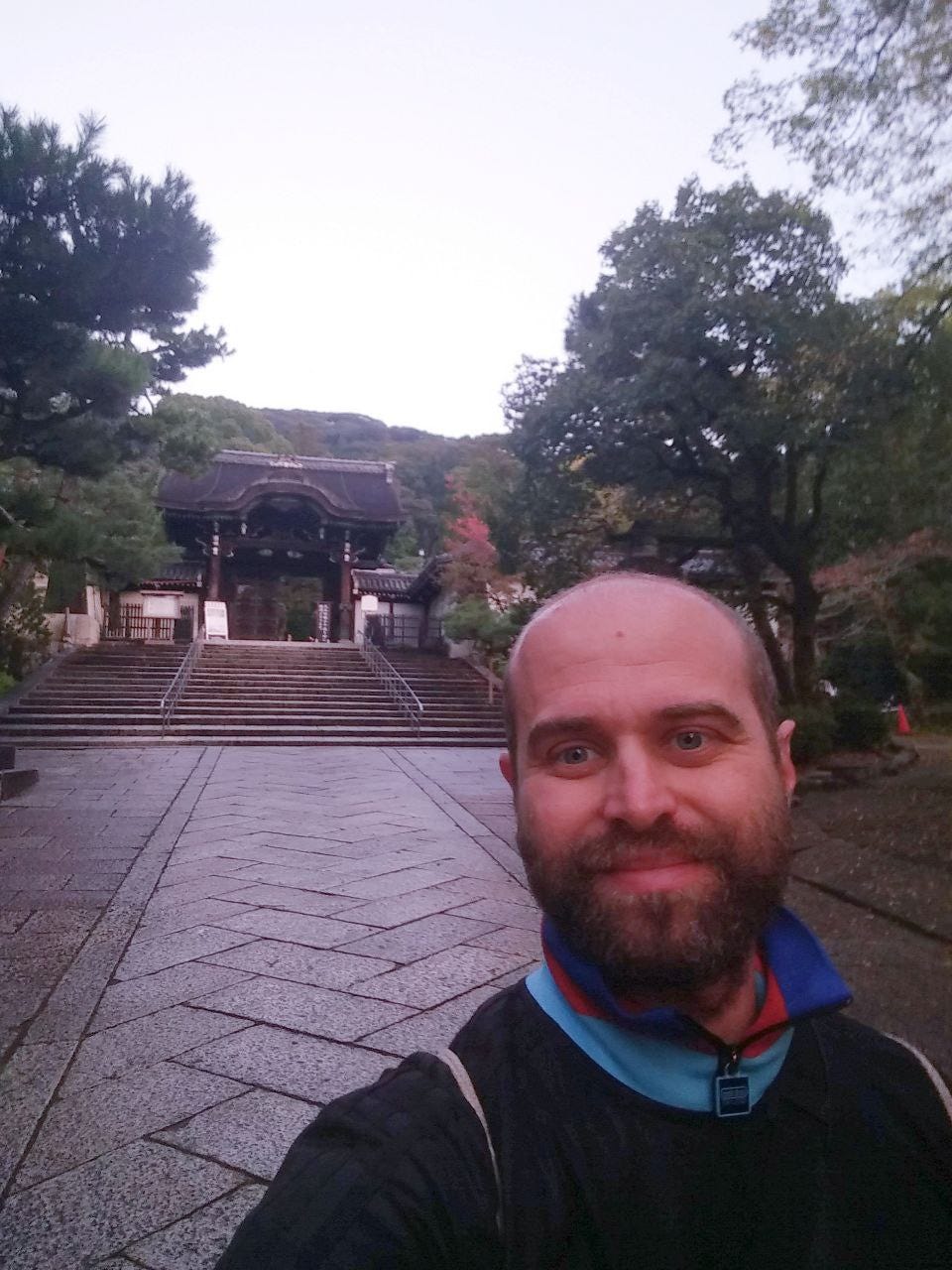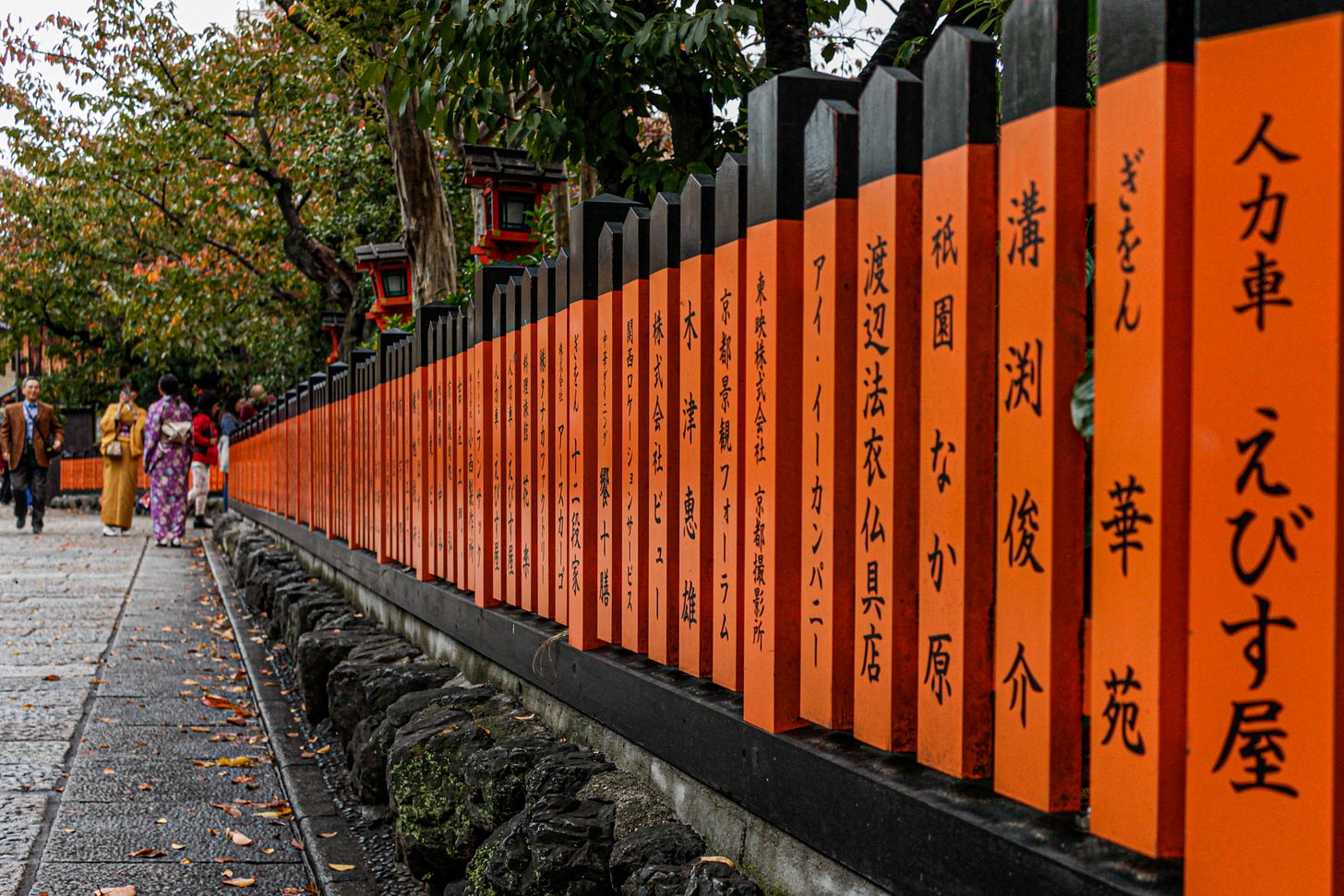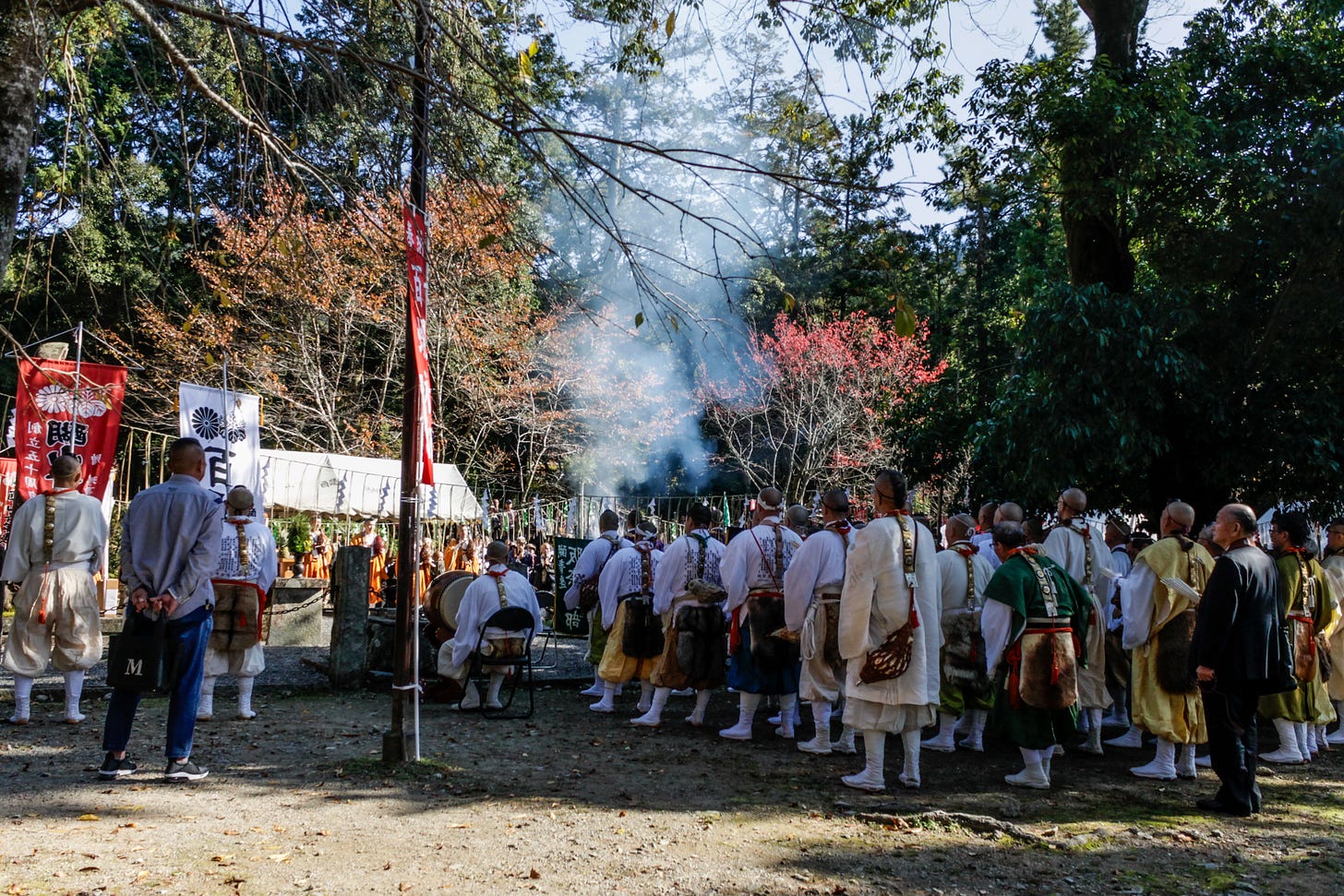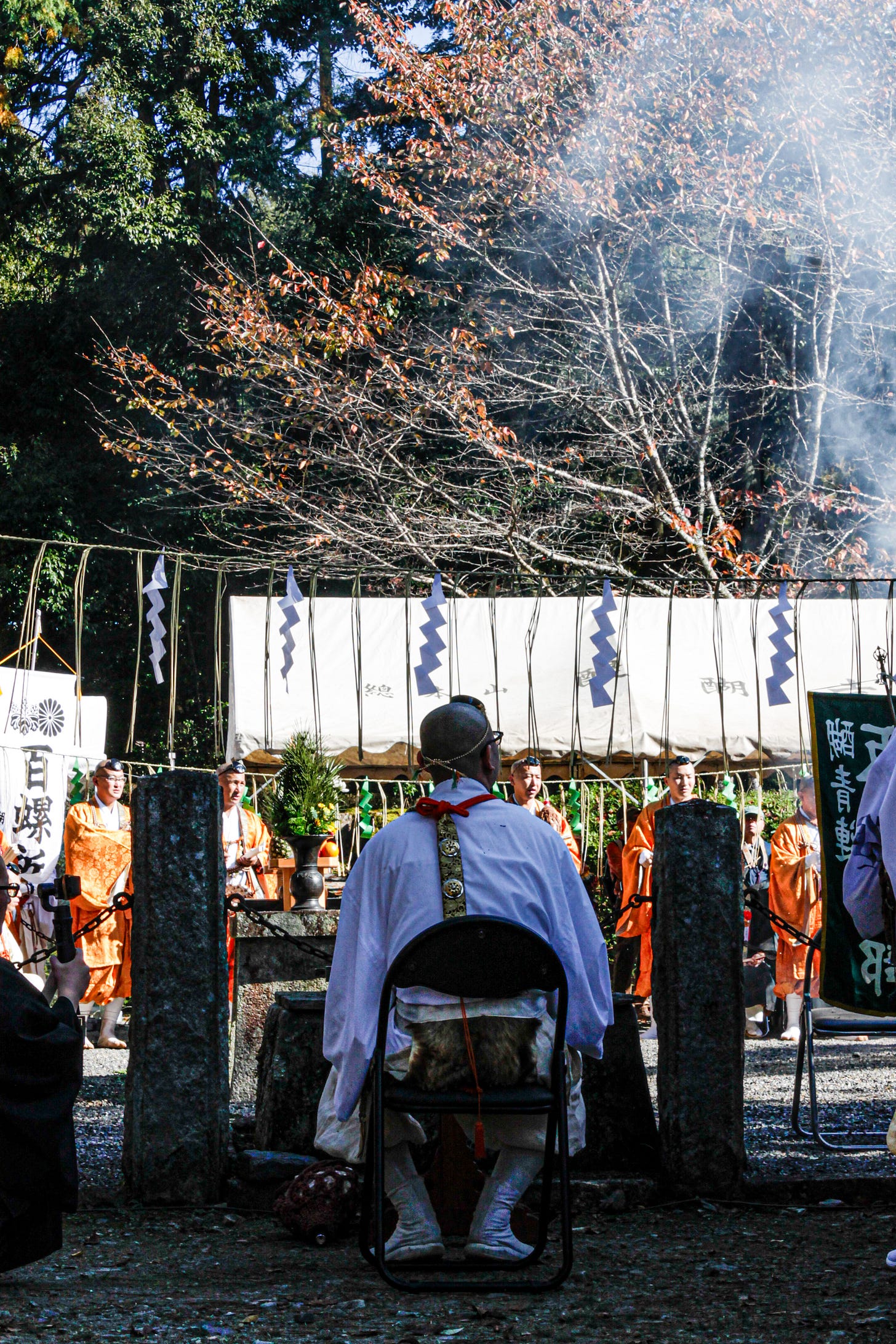My favourite city in Japan, Kyoto!
Closing the Japan series with Kinkaku-ji, Gion, Yasaka Pagoda and Hiroko.
I was coming from Osaka, and Kyoto was the last city before coming back to Europe. I was there for three days and, as I mentioned in the post about Nara, Hiroko hosted me. She had just come back from a long trip to Europe. She started in Japan a few months before and went country by country (South Korea, Hong Kong, Thailand, India, Turkey, and more…) till she arrived in Ireland, from where she went back to Kyoto. We had a lot to talk about, we shared our travel adventures and I had a great time with her.
The old capital of Japan keeps the charm of a traditional Japanese city. In the days I spent there I fell in love with it, you can find something incredible on every corner. It is my favourite city in Japan.
Kyoto whispers tales of samurai, geisha, and serene temples. Its streets are a harmonious blend of tradition and modernity, with historic wooden machiya houses alongside bustling cafes and shops. Wander through the city's immaculate gardens, like the famous Kinkaku-ji (Golden Pavilion) and the peaceful Philosopher's Path, where cherry blossoms paint the landscape in spring. Kyoto's cultural richness is palpable in its tea ceremonies, exquisite kaiseki cuisine, and the elegant art of the geisha. Each corner reveals Japan's captivating history, making Kyoto a timeless destination.
Hiroko worked in a ramen restaurant, from early afternoon till night, she was doing an internship as part of her training to become a chef. In the morning, we had breakfast together and then saw each other around midnight when she returned home. The first morning was raining, but, fortunately, after breakfast it stopped. The first place that I visited was the Kyoto Gyoen National Garden, a vast green expanse nestled within the heart of Kyoto, which is a tranquil haven that offers a respite from the city's hustle and bustle. Once the imperial palace grounds, this expansive park features meticulously manicured lawns, serene ponds, and winding pathways lined with cherry and maple trees.
That morning the park was empty, probably because earlier it was raining, so for me, the feeling was like getting lost in nature. In the park lies the majestic Kyoto Imperial Palace, a symbol of Japan's imperial history and architectural grace. Encircled by lush gardens and protective walls, this serene complex once served as the residence of the Emperor of Japan.
Walking around the imperial palace walls, I discovered that a reservation is needed to visit the palace because the access is only for guided tours. After realising that it was impossible to visit the castle I took a bus and went to see Kinkaku-ji, the Golden Pavilion. Its shimmering facade, adorned in gold leaf, reflects in the tranquil waters of the surrounding pond, creating a breathtaking vista. Originally a retirement villa for a shogun, it was later transformed into a Zen Buddhist temple. Each season paints the temple in a new light, with cherry blossoms in spring and fiery foliage in autumn enhancing its beauty.
It is listed as one of the must-see places, and it was crowded. To be honest, I'm not sure if I can suggest visiting it. It is beautiful but full of tourists and Kyoto has a lot of other beautiful places to offer.
The other place I wanted to visit was Gion. To reach it, I decided to walk beside the river to enjoy the nice weather. The Kamo River, flowing gently through the heart of Kyoto, is a lifeline of tranquillity in this bustling city. I strolled along its banks, enjoying the serene ambience and the soothing sound of flowing water.
While I was there I got a message from Hiroko telling me that when I get home I will find dinner ready, I should just warm it up in the microwave. It was something unexpected that made me smile, these surprising acts of kindness are always heartwarming and remind me of the goodness in people.
Gion exudes an enchanting atmosphere of tradition and elegance. Known as the geisha district, its narrow cobblestone streets are lined with preserved wooden machiya houses, housing exclusive teahouses and restaurants. Here, the ancient art of the geisha thrives, with graceful figures in colourful kimonos occasionally glimpsed among the lantern-lit alleys. As day turns into night, Gion transforms into a magical realm, where the past seamlessly merges with the present, captivating visitors with its timeless charm. The area was built to accommodate the needs of travellers and visitors of the Gion Shrine, and it eventually evolved to become one of the most exclusive and well-known Geisha districts of Japan.
In Gion, there is also Maruyama Park, famous for its majestic cherry trees, it becomes a sea of pink during the spring cherry blossom season. Beyond its seasonal beauty, Maruyama Park boasts tranquil walking paths, a serene pond, and picturesque bridges, creating a peaceful ambience year-round. At its centre stands the iconic weeping cherry tree, illuminated at night, casting a magical glow over the park.
The most famous Shrine in the park is the Yasaka Shrine, a Shinto shrine dedicated to Susanoo (god of the sea and storms) and its vermilion gates and towering pagoda are amazing. As twilight falls, lanterns illuminate the pathways, casting a warm glow over the sacred space, and evoking a sense of reverence and tranquillity.
Walking randomly out of the park I went to Kodaiji Temple, a testament to the splendour of Japan's historical and cultural heritage. Founded in the early 17th century in memory of Toyotomi Hideyoshi by his widow, Nene, the temple boasts stunning architecture, serene gardens, and rich cultural treasures. The temple's lush Zen gardens are complete with tranquil ponds and meticulously pruned trees. Kodaiji is particularly enchanting during the autumn season when the fiery foliage adds a splash of colour to its serene surroundings.
Before going home for dinner I wanted to visit Hokanji Temple, one of the landmarks in Kyoto located in the Higashiyama area, one of the most historical spots in Kyoto. Higashiyama is known for the cobbled alley street that remains the same from the old Kyoto period. Hokanji Temple, also known as Yasaka Pagoda, dates back to the 6th century, this iconic five-story pagoda is a symbol of tranquillity and spiritual devotion. Surrounding the pagoda, the temple's grounds are dotted with stone lanterns and lush gardens, creating a serene atmosphere for reflection and contemplation.
The day after I took a day trip to Nara and Fushimi Inari, you can read about it here.
On my last day in Kyoto, Hiroko and I went to see a temple only because my friend Tami sent me a beautiful Instagram picture of it.
Nestled amidst the serene hills of southeastern Kyoto, Daigo-ji Temple is a testament to Japan's rich cultural heritage and spiritual tradition. Originally founded in the 9th century, Daigo-ji is renowned for its stunning five-story pagoda, which rises majestically above the surrounding forest. The temple's main hall, Sanboin, boasts exquisitely painted screens and intricate woodwork, reflecting the elegant aesthetics of the Heian period.
On that day I was lucky to attend a ceremony beside the Kondō (golden hall) to commemorate the 50th anniversary of the Fudodo, Goma-dojo temple. The monks were singing mantras and, at one point there was a bonfire where monks and the audience were throwing sticks at it. Hiroko told me that the sticks represent wishes that, burning, go directly to the gods. It was nice to have Hiroko with me, so she could explain to me what was going on, otherwise, I wouldn’t have understood.
As I said before, I came here because of an Instagram picture, and the picture was of Bentendo Hall, which was as magical as the one in the picture. Bentendo Hall is dedicated to Benzaiten (Sarasvati), the goddess of knowledge, liberal arts and music, and is generally known as one of the seven deities of good fortune (Shichifukujin).
I was there at the beginning of the Momiji period. Momiji, the Japanese term for maple leaves, holds a special place in the hearts of many for its breathtaking autumnal beauty. As the seasons shift, Japan's landscapes transform into a riot of reds, oranges, and yellows, painting the countryside and city parks alike in a vibrant tapestry of colour. Momiji viewing, or "momijigari," is a cherished tradition where people flock to parks, temples, and mountains to admire the fiery foliage and celebrate the fleeting beauty of autumn.
This was a nice way to say goodbye to one of my favourite cities in the world. In the afternoon I went to Kyoto station to take a Shinkansen fast train to Tokyo, Hiroko came with me to the station to say goodbye and to give me some food for the trip, so thoughtful as usual.
After spending a few days in Tokyo, I came back to Europe and my amazing adventure in Japan finished, this means that for the next post I will talk about something different. I hope you enjoyed my Japanese tales!
See you soon,
Flavio













































Once again, you have me excited for my upcoming trip to Japan. Thanks for the post. I’ll check out these spots.
Beautiful photos. Thank you for sharing.